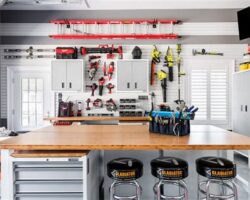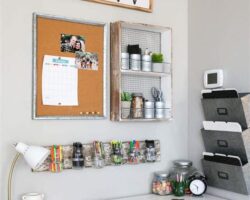Optimizing Space in Your Garage
Having a cluttered and disorganized garage can be a headache for any homeowner. Not only is it frustrating to search for tools and equipment amidst the chaos, but it also limits the functionality of the space. Wouldn’t it be great if you could transform your garage into an organized and efficient workspace? Thankfully, with some careful planning and clever techniques, you can optimize the space in your garage and make it a functional and productive area.
The first step in optimizing your garage space is to declutter and categorize your belongings. Start by sorting through all the items in your garage and decide what you want to keep, donate, or throw away. Be ruthless in your decision-making to maximize the available space. Categorize the items into groups such as gardening tools, sports equipment, and automotive supplies. This will make it easier to find and store items in the future.
Once you have decluttered and categorized, it’s time to consider creative storage solutions. Utilize the vertical space in your garage by installing wall-mounted shelves, pegboards, or hooks. This will not only free up floor space but also make your tools and equipment easily accessible. Additionally, consider investing in stackable bins or clear plastic containers to store smaller items. Label these containers to further enhance organization and efficiency.
In addition to vertical storage, consider utilizing overhead space in your garage. This can be achieved by installing ceiling-mounted racks or shelves. These racks are perfect for storing seasonal items like holiday decorations or sports equipment that are not frequently used. By utilizing these often overlooked areas, you can optimize your garage space and increase its functionality.
In summary, optimizing space in your garage is all about decluttering, categorizing, and utilizing creative storage solutions. By following these steps and making the most of vertical and overhead space, you can transform your garage into an organized and efficient workspace. Say goodbye to the frustration of searching for tools and equipment, and hello to a garage that is both functional and visually appealing.
Choosing Affordable Tools and Equipment
When it comes to pursuing your DIY projects, having the right tools and equipment is essential. However, building up a collection of tools can quickly become expensive. That’s why it’s important to focus on choosing affordable options that still meet your needs. Affordable Tools and Equipment: When it comes to tools, it’s important to strike a balance between quality and price. While it can be tempting to opt for the cheapest option available, this may result in tools that are not durable or do not perform well. On the other hand, high-end tools may be out of your budget. Therefore, it’s important to do your research and find tools that offer a good combination of affordability and quality.
Consider Secondhand Options: One way to save money on tools and equipment is to consider purchasing secondhand items. Many people sell their lightly used tools at a fraction of the original price, allowing you to get your hands on quality tools without breaking the bank. You can check online platforms such as Craigslist or local buy-and-sell groups to find these deals. Just make sure to thoroughly inspect the items before purchasing to ensure they are in good working condition.
Compare Prices: Another strategy for choosing affordable tools and equipment is to compare prices from different retailers. Don’t settle for the first option you come across; instead, take the time to research and compare prices from multiple sources. You may find that prices vary significantly, and by shopping around, you can find the best deal. Additionally, keep an eye out for sales, discounts, and promotions that can help you save even more money.
Make a List: Before you go tool shopping, it’s important to make a list of the tools you actually need. This will help you stay focused and avoid impulse purchases. By prioritizing your needs and sticking to your list, you can ensure that you are investing in tools that will be useful for your specific projects. Additionally, having a list can help you spot opportunities to bundle items together or take advantage of bulk discounts.
Consider Tool Rental: If you only need a specific tool for a one-time project, it may be more cost-effective to rent rather than buy. Many hardware stores and home improvement centers offer tool rental services, allowing you to borrow tools for a fraction of the purchase price. This can be particularly useful for larger, more expensive tools that you may not use frequently. Just make sure to familiarize yourself with any rental policies and return the tool in good condition to avoid extra charges.
| Pros of Choosing Affordable Tools and Equipment: | Cons of Choosing Affordable Tools and Equipment: |
|---|---|
|
|
Creative Storage Solutions on a Budget
When it comes to organizing our garage, finding creative storage solutions on a budget can be a real challenge. The garage tends to become a dumping ground for all the items we don’t use regularly, making it difficult to find what we need when we need it. But fear not! With a little ingenuity and resourcefulness, it is possible to transform your cluttered garage into an organized and functional space without breaking the bank.
Listed below are some tips and tricks to help you get started:
- Reuse and repurpose: Look for unused or discarded items around the house that can be repurposed into storage solutions. For example, an old wooden ladder can be mounted on the wall to create hanging storage for tools and gardening equipment. Empty glass jars can be screwed onto the underside of shelves to store small items like screws and nails.
- Maximize vertical space: Make use of the often-overlooked vertical space in your garage. Install shelving units or racks that can be mounted on the walls to store items like paint cans, car care products, and sports equipment. By utilizing vertical space, you can free up valuable floor space and make it easier to find what you need.
- Utilize overhead storage: If your garage has high ceilings, take advantage of that space by installing overhead storage racks. These racks can be used to store items that are used less frequently, such as holiday decorations or seasonal clothing. It’s a great way to keep these items out of the way while still keeping them easily accessible.
In addition to these tips, consider creating a storage plan tailored to your specific needs:
| Category | Storage Solution |
|---|---|
| Tools | Hang pegboards on the wall to organize and display your tools. Use hooks and holders to keep everything in its place. |
| Sports Equipment | Invest in wall-mounted racks or freestanding shelving units specifically designed to hold sports equipment. This will keep everything organized and prevent any damage. |
| Gardening Supplies | Install a vertical garden tool rack on the wall to hang your gardening tools. Use bins or buckets to store smaller items like seeds and plant markers. |
| Seasonal Decorations | Label and store seasonal decorations in clear plastic bins. Stack them neatly on shelves or use overhead storage racks to keep them out of the way until needed. |
By following these creative storage solutions on a budget, you can transform your garage into a well-organized space that is both functional and aesthetically pleasing.
DIY Workbenches: Building on a Shoestring
When it comes to setting up a workshop or workspace, having a sturdy and functional workbench is essential. However, buying a pre-made workbench can be quite expensive, especially if you’re on a tight budget. But don’t worry, because with a little creativity and resourcefulness, you can build your own DIY workbench without breaking the bank. In this blog post, we will explore some tips and ideas for building a workbench on a shoestring budget.
1. Repurposing materials: One of the best ways to save money on building a workbench is by using recycled or repurposed materials. Look around your house or in your garage for any unused items that can be transformed into a workbench. Old doors, old cabinets, or even sturdy wooden pallets can be excellent foundations for your workbench.
2. Basic design: Keep the design of your workbench simple and functional. You don’t need complicated features or fancy add-ons. A basic rectangular shape with a solid top surface will suffice for most DIY projects. This will not only save you money but also make the construction process easier.
3. Consider adjustable height: While this may add a bit of complexity and cost, building an adjustable-height workbench can be a great investment. Being able to adjust the height of your workbench will make it more comfortable to work on and can accommodate various projects and tasks. Consider using adjustable table legs or building a workbench with multiple layers that can be adjusted individually.
List of materials:
| Materials | Quantity |
|---|---|
| Recycled door | 1 |
| 4×4 wooden beams | 4 |
| Plywood | 1 sheet |
| Screws | Various sizes |
| Wood glue | 1 bottle |
These are just a few ideas to get you started on building your DIY workbench on a shoestring budget. The key is to be resourceful and think outside the box. With a little effort and creativity, you can have a functional and affordable workbench that meets all your needs. Happy building!
Repurposing Household Items for Workshop Use
When it comes to setting up a workshop, the cost of tools and equipment can quickly add up. However, there are ways to save money by repurposing household items for workshop use. By thinking creatively and utilizing items you already have, you can create functional and cost-effective solutions for your workshop needs.
One of the easiest ways to repurpose household items for workshop use is by using old jars and containers for storage. Instead of throwing them away, clean them out and use them to store small items such as screws, nails, and bolts. You can even label them for easy organization. Not only does this save you money on buying expensive storage containers, but it also helps reduce clutter in your workshop.
Another household item that can be repurposed for workshop use is an old ladder. Instead of letting it gather dust in the garage, turn it into a vertical storage solution. Simply mount it on the wall and use the rungs to hang tools such as hammers, screwdrivers, and wrenches. This not only keeps your tools within reach but also adds a unique and rustic touch to your workshop decor.
- Jars and containers: Repurpose old jars and containers for storage of small items like screws and bolts.
- Old ladder: Transform an old ladder into a vertical storage solution by mounting it on the wall.
Tables are another household item that can be repurposed for workshop use. Whether it’s an old dining table or a sturdy desk, you can easily turn it into a workbench. Simply add a sheet of plywood or MDF to the top and secure it in place. This provides you with a large and stable surface to work on without the need to purchase a separate workbench. Plus, you can still use the table for its original purpose when you’re not working in the workshop.
| Household Item | Workshop Use |
|---|---|
| Old jars and containers | Storage for small items |
| Old ladder | Vertical tool storage |
| Old table | Workbench |
Lastly, don’t overlook the potential of old wooden crates for workshop organization. These versatile crates can be used to store larger items such as power tools or paint cans. You can stack them or mount them on the wall for easy access. Additionally, wooden crates can be easily customized with paint or stain to match your workshop’s aesthetic.
Repurposing household items for workshop use not only helps you save money but also encourages sustainable practices by giving new life to items that may have otherwise been discarded. So before you rush to the store to buy expensive workshop solutions, take a look around your house and see what household items you can repurpose.
Budget-Friendly Lighting and Electrical Solutions
When it comes to lighting and electrical solutions for your home, it’s important to find options that not only brighten up your space but also fit within your budget. With a little creativity and resourcefulness, you can achieve a well-lit and functional area without breaking the bank. In this blog post, we will explore a variety of budget-friendly lighting and electrical solutions that will help you create the perfect ambiance in your home.
There are several **cost-effective** lighting options available that can add charm and functionality to your space. One popular option is to use **LED bulbs** instead of traditional incandescent bulbs. LED bulbs are durable, energy-efficient, and have a longer lifespan, making them an excellent choice for budget-friendly lighting. Additionally, you can consider installing **motion-sensor lights** in areas such as hallways or closets. These lights only turn on when motion is detected, saving you both energy and money.
Another way to achieve budget-friendly lighting is by utilizing natural light. **Maximize sunlight** by keeping windows clean and clear of obstructions. Consider using **light-colored curtains or blinds** that allow natural light to filter in without compromising privacy. Additionally, strategically placing **mirrors** across from windows can help reflect and amplify natural light throughout the room.
| Product | Price | Features |
|---|---|---|
| LED Bulbs | $5 | Energy-efficient, longer lifespan |
| Motion-Sensor Lights | $15 | Turn on only when motion is detected |
| Light-colored Curtains/Blinds | $20 | Allow natural light while maintaining privacy |
| Mirrors | $10 | Reflect and amplify natural light |
When it comes to electrical solutions, it’s important to prioritize safety while still staying within your budget. **Outlet timers** are an affordable and convenient way to control the usage of electrical devices. By setting specific times for devices to turn on and off, you can save energy and reduce your electricity bill. Additionally, **power strips** with surge protectors are a wise investment. They not only provide extra outlets but also protect your electronic devices from power surges.
Furthermore, **repurposing** old household items can also help you save money on electrical solutions. For example, you can transform an old mason jar into a stylish **pendant light** by adding a simple bulb holder and some wiring. This not only adds a unique touch to your space but also eliminates the need to purchase expensive light fixtures.
In conclusion, achieving budget-friendly lighting and electrical solutions is possible with some creativity and smart choices. By opting for LED bulbs, utilizing natural light, and repurposing household items, you can effectively **illuminate** your space without exceeding your budget. Remember to prioritize safety and consider the long-term savings when making decisions about lighting and electrical solutions for your home.
Saving on Materials: Thrifty Tips and Tricks
The key to saving on materials for any project is to be thrifty and resourceful. By using some simple tips and tricks, you can stretch your budget and make the most of what you have. Whether you’re working on a DIY project or a professional construction job, these strategies will help you keep costs down without sacrificing quality.
One of the first things you can do to save on materials is to **re-purpose** items you already have. Look around your home or workshop for unused or abandoned materials that could be used in your project. **Old wooden pallets** can be transformed into shelves or tables, while **scrap metal** can be transformed into decorative accents. Get creative and think outside the box to find new purposes for old items.
Another way to save on materials is to **buy in bulk**. When purchasing materials, such as lumber or paint, buying in larger quantities can often save you money in the long run. Many suppliers offer discounted rates for bulk orders, so take advantage of these deals if possible. Just make sure you have enough space to store the extra materials until you need them.
Additionally, **shopping around** and comparing prices from different suppliers can help you find the best deals. Don’t settle for the first price you see – take the time to research and find the most affordable options. Look for sales, discounts, or clearance items that can help you save even more. Online marketplaces and discount stores can often offer lower prices than traditional home improvement stores.
Finally, consider **reusing and recycling** materials whenever possible. Instead of buying new materials, see if you can repurpose items from previous projects or find them secondhand. For example, old windows can be turned into unique picture frames, or scrap wood can be used to build small furniture pieces. Not only will this save you money, but it’s also an eco-friendly choice.
In conclusion, saving on materials is all about being thrifty and resourceful. By re-purposing items, buying in bulk, shopping around, and reusing materials, you can keep costs down and complete your project within budget. Don’t be afraid to get creative and think outside the box – you might be surprised by what you can come up with!
Frequently Asked Questions
Q1: How can I optimize space in my garage?
To optimize space in your garage, consider installing wall-mounted shelves, using pegboards for tool storage, and utilizing overhead storage systems. You can also create designated zones for different purposes, such as a workshop area and a storage area.
Q2: What are some affordable tools and equipment options?
When it comes to affordable tools and equipment, consider purchasing used items from garage sales or online marketplaces. You can also borrow tools from neighbors or friends, or rent them from a local equipment rental store.
Q3: How can I find creative storage solutions on a budget?
For creative storage solutions on a budget, repurpose household items such as old cabinets, crates, or shoe organizers for tool and equipment storage. Utilize vertical space by using wall-mounted hooks or racks, and make use of unused spaces, such as the area above the garage door.
Q4: How do I build a DIY workbench on a shoestring budget?
To build a DIY workbench on a shoestring budget, consider using reclaimed or repurposed materials, such as old doors or salvaged wood. You can also customize the size and design of the workbench to suit your specific needs, which can help save money on materials.
Q5: What are some household items that can be repurposed for workshop use?
Several household items can be repurposed for workshop use, such as empty jars for storing nails and screws, egg cartons for organizing small parts, and old t-shirts for cleaning tools or surfaces. Be creative and think outside the box to find functional uses for everyday items.
Q6: How can I save on lighting and electrical solutions?
To save on lighting and electrical solutions, consider using energy-efficient LED bulbs, which consume less electricity and have a longer lifespan. Utilize natural lighting by installing windows or skylights, and use task lighting where necessary instead of lighting up the entire garage.
Q7: What are some thrifty tips and tricks for saving on materials?
To save on materials, try repurposing or upcycling items instead of purchasing new ones. Look for discounted or second-hand materials at salvage yards or clearance sections of home improvement stores. You can also join local online communities or forums to connect with others who might have excess materials to give away or sell at a lower price.





